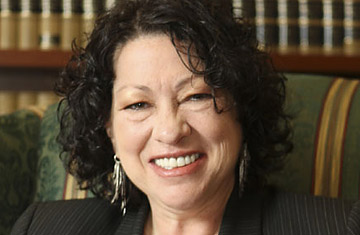
Judge Sotomayor in 2009
When David Souter was nominated by George H.W. Bush to the Supreme Court, the jurist had so little in the way of a record of past rulings that people called him "the stealth nominee." There's no such problem with Sonia Sotomayor, the woman Barack Obama just chose to replace Souter on the court. The same President Bush picked her to be a federal district judge in 1991, just a year after he elevated Souter, so she will come to her confirmation hearings not just as the child of Puerto Rican parents who went from public housing to Princeton, but also as a judge with a nearly 17-year paper trail of decisions.
What those decisions offer is a portrait of a moderately liberal jurist, one who may disappoint activists on the left who were hoping that Obama would choose a two-fisted progressive to trade punches with Justice Antonin Scalia, who anchors the conservative end of the court. On Thursday, when he met her for the first time, Obama, a former law professor, engaged Sotomayor, who rose to the federal appeals court in 1998, in a lengthy discussion about the court and the Constitution. Earlier Tuesday, a senior adviser to the President told TIME, "What the President told us afterward was that he was very struck by her discussion of her approach to judging, how effective she has been in working with her colleagues on the Second Circuit, including colleagues appointed by Republican Presidents, and how her judicial craftsmanship and precision in the law can be effective in bridging ideological differences and producing consensus opinions." (See a graphic of Obama's first 100 days in office.)
Sotomayor's involvement in an affirmative-action case last year will probably attract the most attention in weeks to come. The case, Ricci v. DeStefano, involves a group of white firefighters, including one Hispanic. The group filed a discrimination suit against the city of New Haven, Conn., after the city decided not to certify the results of a job-promotion exam because no African Americans had scored high enough to be promoted. A lower court decided in favor of the city. In February 2008, Sotomayor was part of a three-judge panel that upheld the lower court's decision. Four months later, she was part of a 7-6 majority that decided not to rehear the case before the full appeals court. (See pictures of Judge Sonia Sotomayor.)
That case is now before the Supreme Court, which heard arguments last month. Its ruling is pending. The Justices have already reversed three rulings Sotomayor had joined. But unlike the affirmative-action case, most of those involved technical issues that would be hard to build an opposition campaign around. Two years ago, a 6-3 court overturned a Sotomayor appellate ruling that determined that the Environmental Protection Agency could not use cost-benefit analysis when deciding whether to require power plants to take steps to limit their impact on aquatic life. In another case, Sotomayor ruled that investors could bring certain kinds of fraud suits against investment firms in state court rather than in federal court. The Supreme Court unanimously overturned that decision, ruling that to permit the suits in state court would lead to "duplicative litigation."
Interestingly, seven years ago, Sotomayor decided against an abortion-rights group that attempted to challenge the federal ban — since lifted by President Obama — on funding to international family-planning groups that provide abortions. In a ruling to uphold a lower-court's decision that threw out the case, Sotomayor wrote, "The Supreme Court has made clear that the government is free to favor the anti-abortion position over the pro-choice position, and can do so with public funds." But that case didn't require Sotomayor to comment on the fundamental premise of Roe v. Wade, that the Constitution provides a right to abortion.
Conservatives who want to go after Sotomayor may find more ammunition in some of her public statements outside of court. In a panel discussion at Duke University four years ago, Sotomayor said the federal court of appeals is where "policy is made," the kind of statement that can get you tagged as an activist judge who tries to make law instead of interpret it. Sotomayor appeared to know that was the danger in the words she had just let slip, because she quickly added, "And I know that this is on tape, and I should never say that. Because we don't 'make law' ... I'm not promoting it, and I'm not advocating it." (See four myths about Supreme Court nominees.)
In a 2001 speech at the Berkeley campus of the University of California, Sotomayor aired the view that a judge's gender and ethnic background inevitably affect his or her decision-making, and probably should. She said then, "Justice O'Connor has often been cited as saying that a wise old man and wise old woman will reach the same conclusion in deciding cases. I am also not so sure that I agree with the statement ... I would hope that a wise Latina woman with the richness of her experience would more often than not reach a better conclusion than a white male who hasn't lived that life."
In truth, like that of most lower-court judges, much of Sotomayor's history on the bench has involved the minute application of legal technicalities, not the kind of cases in which life experience, even one as inspiring as hers, would have offered much guidance. There may be more cases of that kind on the Supreme Court — when and if she gets there.
